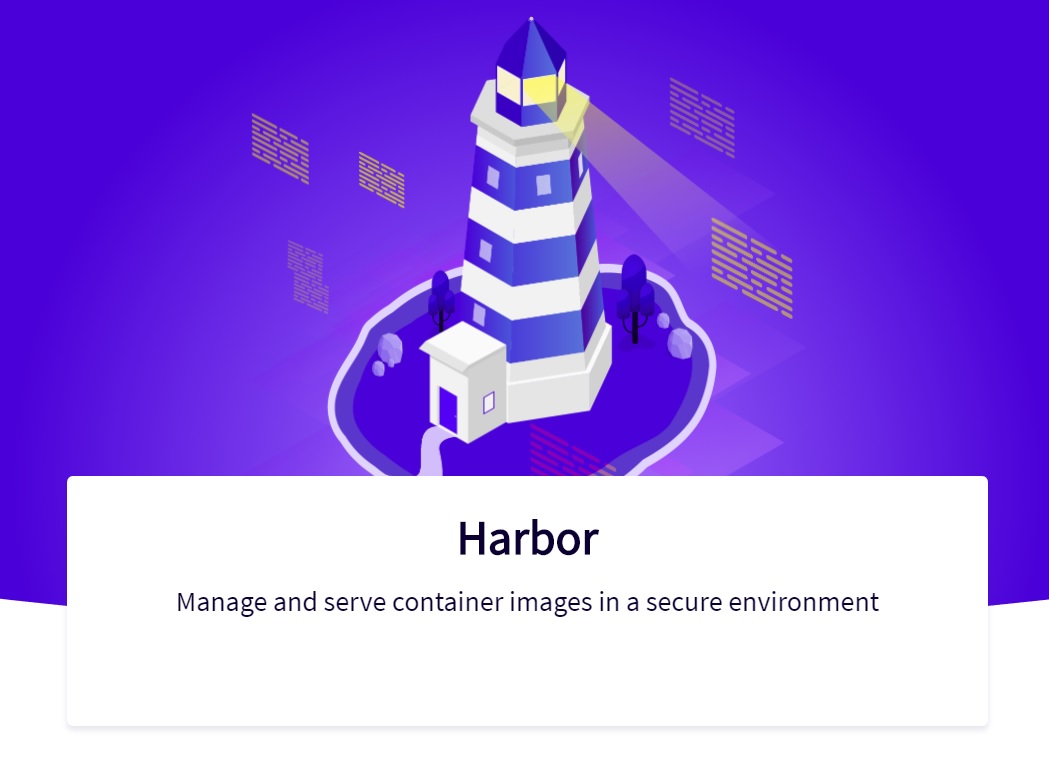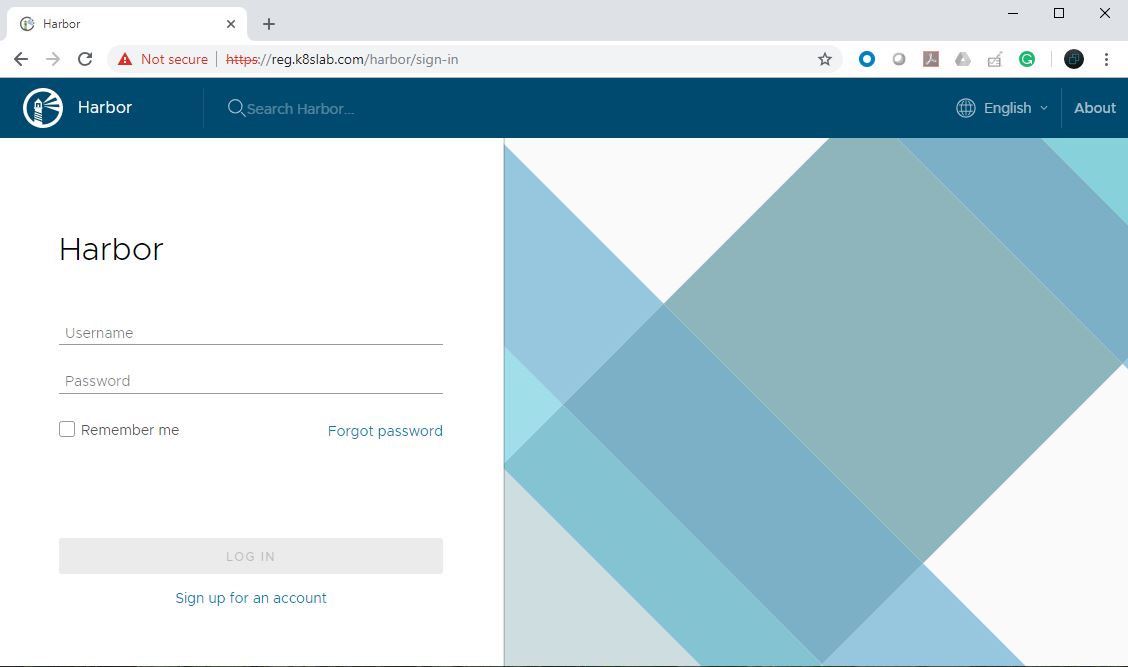Setup Harbor
All container images that we used in the previous examples were downloaded from Docker Hub which is a public registry.
But in production environments , we have to use private image registry so that we will have better control of images and its security.
In this session , we will deploy a private registry using Harbor
Students needs to deploy this in a separate Ubuntu 16.04 LTS VM (4GB memmory + 2vCPUs). If you are attending live session , then instructor will provide private registry URL and credentials.
In this lab , we use below IP/FQDN. Make sure to create necessary DNS entries or /etc/hosts entries to use the registry once configured.
IP Address : 10.136.102.79
FQDN: k8s-harbor-registry.linxlabs.com
Install Docker
$ curl -fsSL https://download.docker.com/linux/ubuntu/gpg | sudo apt-key add -
$ sudo add-apt-repository "deb [arch=amd64] https://download.docker.com/linux/ubuntu $(lsb_release -cs) stable"
$ sudo apt-get update
$ sudo apt-get install -y docker-ce
Verify Docker service state
$ sudo systemctl status docker --no-pager --lines 0
Example output
● docker.service - Docker Application Container Engine
Loaded: loaded (/lib/systemd/system/docker.service; enabled; vendor preset: enabled)
Active: active (running) since Fri 2020-04-10 20:49:29 IST; 2min 27s ago
Docs: https://docs.docker.com
Main PID: 4315 (dockerd)
CGroup: /system.slice/docker.service
└─4315 /usr/bin/dockerd -H fd:// --containerd=/run/containerd/containerd.sock
Download docker-compose binary
$ sudo curl -L "https://github.com/docker/compose/releases/download/1.25.5/docker-compose-$(uname -s)-$(uname -m)" -o /usr/local/bin/docker-compose
$ sudo chmod +x /usr/local/bin/docker-compose
$ sudo ln -s /usr/local/bin/docker-compose /usr/bin/docker-compose
Setup Certificates
Create a staging directory first
mkdir ~/harbor_certs/
cd ~/harbor_certs/
Create CA
openssl genrsa -out ca.key 4096
openssl req -x509 -new -nodes -sha512 -days 3650 \
-subj "/C=IN/ST=Kerala/L=Kollam/O=demo/OU=Personal/CN=ca.linxlabs.com" \
-key ca.key \
-out ca.crt
Create SSL extension file
cat > v3.ext <<-EOF
authorityKeyIdentifier=keyid,issuer
basicConstraints=CA:FALSE
keyUsage = digitalSignature, nonRepudiation, keyEncipherment, dataEncipherment
extendedKeyUsage = serverAuth
subjectAltName = @alt_names
[alt_names]
DNS.1=linxlabs.com
DNS.2=k8s-harbor-registry.linxlabs.com
DNS.3=k8s-harbor-registry
EOF
Create a Ceertificate Signing Request(CSR) for Harbor’s nginx service
$ openssl genrsa -out server.key 4096
$ openssl req -sha512 -new \
-subj "/C=IN/ST=Kerala/L=Kollam/O=demo/OU=Personal/CN=k8s-harbor-registry.linxlabs.com" \
-key k8s-harbor-registry.linxlabs.com.key \
-out k8s-harbor-registry.linxlabs.com.csrGenerate and Sign Certificates
$ openssl x509 -req -sha512 -days 3650 \
-extfile v3.ext \
-CA ca.crt -CAkey ca.key -CAcreateserial \
-in k8s-harbor-registry.linxlabs.com.csr \
-out k8s-harbor-registry.linxlabs.com.crtAfter signing , we will get output like below
Signature ok
subject=/C=IN/ST=Kerala/L=Kollam/O=demo/OU=Personal/CN=k8s-harbor-registry.linxlabs.com
Getting CA Private Key
Create certificate directory for harbor
$ sudo mkdir -p /data/cert/
$ sudo cp k8s-harbor-registry.linxlabs.com.crt k8s-harbor-registry.linxlabs.com.key /data/cert/Download Harbor offline installer.
$ sudo curl https://storage.googleapis.com/harbor-releases/release-1.7.0/harbor-offline-installer-v1.7.1.tgz -O$ tar -xvf harbor-offline-installer-v1.7.1.tgzConfigure Harbor.
$ cd harbor
$ sed -i 's/hostname: reg.mydomain.com/hostname: k8s-harbor-registry.linxlabs.com/' harbor.yml
$ sed -i 's@ certificate: /your/certificate/path@ certificate: /data/cert/k8s-harbor-registry.linxlabs.com.crt@' harbor.yml
$ sed -i 's@ private_key: /your/private/key/path@ private_key: /data/cert/k8s-harbor-registry.linxlabs.com.key@' harbor.yml$ grep k8s-harbor harbor.yml
hostname: k8s-harbor-registry.linxlabs.com
certificate: /data/cert/k8s-harbor-registry.linxlabs.com.crt
certificate: /data/cert/k8s-harbor-registry.linxlabs.com.keyInstall Harbor & Start Harbor.
$ sudo ./install.sh --with-notary --with-clair --with-chartmuseumAfter successful installation , we will get below output.
[Step 5]: starting Harbor ...
Creating network "harbor_harbor" with the default driver
Creating network "harbor_harbor-clair" with the default driver
Creating network "harbor_harbor-notary" with the default driver
Creating network "harbor_harbor-chartmuseum" with the default driver
Creating network "harbor_notary-sig" with the default driver
Creating harbor-log ... done
Creating redis ... done
Creating registry ... done
Creating registryctl ... done
Creating chartmuseum ... done
Creating harbor-portal ... done
Creating harbor-db ... done
Creating notary-signer ... done
Creating clair ... done
Creating harbor-core ... done
Creating notary-server ... done
Creating nginx ... done
Creating harbor-jobservice ... done
Creating clair-adapter ... done
✔ ----Harbor has been installed and started successfully.----Also , you can use docker-compose to verify the health of containers
$ sudo docker-compose ps
Name Command State Ports
---------------------------------------------------------------------------------------------------------------------------------------
chartmuseum ./docker-entrypoint.sh Up (healthy) 9999/tcp
clair ./docker-entrypoint.sh Up (healthy) 6060/tcp, 6061/tcp
clair-adapter /clair-adapter/clair-adapter Up (healthy) 8080/tcp
harbor-core /harbor/harbor_core Up (healthy)
harbor-db /docker-entrypoint.sh Up (healthy) 5432/tcp
harbor-jobservice /harbor/harbor_jobservice ... Up (healthy)
harbor-log /bin/sh -c /usr/local/bin/ ... Up (healthy) 127.0.0.1:1514->10514/tcp
harbor-portal nginx -g daemon off; Up (healthy) 8080/tcp
nginx nginx -g daemon off; Up (healthy) 0.0.0.0:4443->4443/tcp, 0.0.0.0:80->8080/tcp, 0.0.0.0:443->8443/tcp
notary-server /bin/sh -c migrate-patch - ... Up
notary-signer /bin/sh -c migrate-patch - ... Up
redis redis-server /etc/redis.conf Up (healthy) 6379/tcp
registry /home/harbor/entrypoint.sh Up (healthy) 5000/tcp
registryctl /home/harbor/start.sh Up (healthy)Now , you will be able to access Harbor UI using URL “https://k8s-harbor-registry.linxlabs.com” (Need DNS entry/host file entry) or use the IP of the VM “https://10.136.102.79”
Default username & password is admin/Harbor12345

